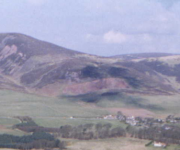This is a brief outline of how I believe the Harkness name originated and of its early history in Scotland. More detailed information on each stage of this journey is, or will be, available in other parts of the web site.
On the first Friday in August 1280 Thomas de Hardkneys is recor ded as a tenant farmer in the Pentland Hills area south of Edinburgh. It is not known how long the family had resided there but the document recording his presence mentions that local knowledge extended back ‘for fifty years or more’, suggesting that some stability existed for inhabitants in the area. This was soon to change when in 1286 the Scottish king Alexander III died suddenly and disputes followed as to his successor resulting in the invasion of Scotland in 1296 by Edward I of England. The area around the Pentland Hills, along with much of central Scotland, became a war zone. The Scots devastated the area with a scorched earth policy to deprive the English army of supplies, and the English plundered everything that was left. Normal life was impossible. There is no record of what happened to Thomas or his family during this period.
ded as a tenant farmer in the Pentland Hills area south of Edinburgh. It is not known how long the family had resided there but the document recording his presence mentions that local knowledge extended back ‘for fifty years or more’, suggesting that some stability existed for inhabitants in the area. This was soon to change when in 1286 the Scottish king Alexander III died suddenly and disputes followed as to his successor resulting in the invasion of Scotland in 1296 by Edward I of England. The area around the Pentland Hills, along with much of central Scotland, became a war zone. The Scots devastated the area with a scorched earth policy to deprive the English army of supplies, and the English plundered everything that was left. Normal life was impossible. There is no record of what happened to Thomas or his family during this period.
During Scotland’s Wars of Independence from 1296 until well into the 14th century, the Douglas family played a key role. Sir James Douglas, ‘Good Sir James’ to the Scots and ‘The Black Douglas’ to his enemies, was King Robert the Bruce’s right hand man. The Douglas family were richly rewarded by given lands throughout the south of Scotland. They acquired extensive property in Lanarkshire, Roxburghshire and Dumfries and Galloway. Much of that land is still owned by their successor, the Duke of Buccleuch. In 1334/35, while Scotland was still fighting for its survival, William Douglas, the Knight of Liddesdale, recruited men from the Pentland Hills to fight the English in the Edinburgh area. The Douglas/Harkness connection may have begun or continued then.
The next Harkness family record is in July 1434 when Thomas Hardkneis, notary public in Peebles, only thirteen miles from the Hardkneys farm in the Pentlands, witnessed a land transaction. In April 1447 John Herknes, chaplain, witnessed a charter in Peebles. In 1407 William Hay was appointed hereditary Sheriff of Peebles and his descendant, David Haye, Sheriff of Peebles, is mentioned in some of the records witnessed by Thomas and John Harkness. The Hays were closely associated with and supporters of the Douglas family.
From the late 1400s there are Harkness records in areas of the south of Scotland dominated by the Douglas family. Some of the records name specific farms occupied by Harkness tenants rented from Douglas estates. There are also records of Harkness in Edinburgh from the 1500s.
In the 16th and early 17th century early records show many Harknesses living in Dumfries and Galloway and in Roxburghshire, the heart land of the Reivers and inevitably involved in Reiving. After 1603 when James VI of Scotland became James I of the United Kingdom the Reivers were no longer required politically, and a purge was carried out by the government. Many of those who had for generations fought to maintain the Border between England and Scotland, were ‘encouraged’ to take part in the colonisation of Northern Ireland – the Plantations. In the early 1700s many of these Ulster Scots went on to emigrate to North America where they played an important role in the development of the United States, Canada and the Caribbean.
Later in the 1600s, Harkness family members, particularly those in the adjoining Dumfriesshire farms of Locherben and Mitchellslacks, both Douglas/Buccleuch Estates farms, played an important part in the Covenanting Movement.
During the 18th, 19th and 20th centuries, Harknesses continued to emigrate from Scotland and Northern Ireland and to play an important part particularly in the development of the United States, Canada, Australia and New Zealand.
